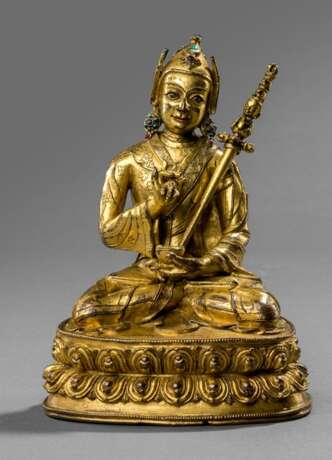ID 13278
Lot 34 | Der "Kostbare Guru" Padmasambhava
Estimate value
€ 35 000
H. 16 cm
Kupferlegierung, schöne Feuervergoldung, Glas und Halbedelsteine, feine Gravierungen der Gewandsäume mit Rauten- und Blütenmustern; originale Verschlussplatte mit eingraviertem Doppelvajra. Guru Padmasambhava oder, der "Kostbare Guru", wie der große Gelehrte und Magier von den Tibetern auch genannt wird, gilt innerhalb der tantrischen Tradition des tibetischen Buddhismus als der zweite Buddha unseres gegenwärtigen Zeitalters. Ohne Begrenzung durch Zeit und Raum, Geburt und Tod, tritt Padmasmbhava, seit seiner ersten Erscheinung als "Lotusgeborener" und seiner Verwirklichung des "Großen Regenbogenkörpers", immer wieder in verschiedenen Gestalten und unter verschiedenen Namen auf. Diese stehen aufs Engste mit seiner spirituellen Entwicklung und seinem segensreichen Wirken, an den jeweiligen Orten, in Verbindung. Hier in dieser edlen Skulptur zeigt er sich in seiner traditionellen Erscheinungsform mit mehrfach übereinanderliegenden Kleidungsstücken, seinem traditionellen Lotoshut, und seinen Stiefeln. Der Lotoshut ist geschmückt mit den Symbolen von Sonne und Mond und dem Doppelvajra. Die Geierfeder auf der Spitze seines Hutes ist abgebrochen. In seiner rechten vor dem Herzen erhobenen Hand hält er das Diamantszepter (skr. Vajra), und in seiner linken im Schoß ruhenden eine nach oben offene und gefüllte Schädelschale (Kapala). In seine linke Armbeuge hat der Guru einen Stab geklemmt - Symbol seiner mystischen Partnerin - (skr. Khatvanga). Die Augen des tantrischen Meisters sind in der Tradition des Dzogchen, zielgerichtet in die Weite gerichtet.
Provenienz: Aus einer bedeutenden europäischen Privatsammlung - Minim. berieben
| Address of auction |
Nagel Auktionen GmbH Neckarstrasse 189 - 191 70190 Stuttgart Germany | ||||||||||||||
|---|---|---|---|---|---|---|---|---|---|---|---|---|---|---|---|
| Preview |
| ||||||||||||||
| Phone | +49 (0)711 649 690 | ||||||||||||||
| Fax | +49 (0)711 649 69696 | ||||||||||||||
| Buyer Premium | 29,5% | ||||||||||||||
| Conditions of purchase | Conditions of purchase | ||||||||||||||
| Business hours | Business hours
|




